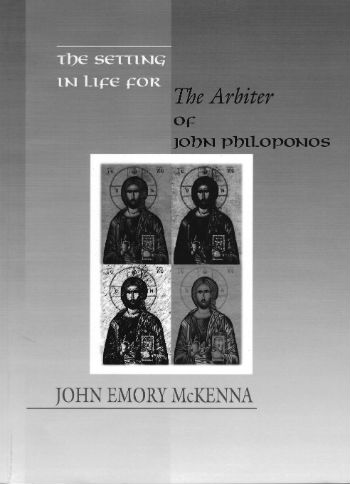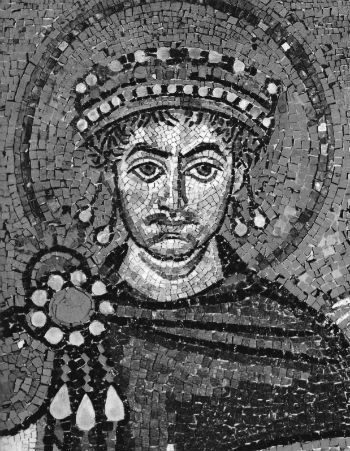John Philoponus: Pioneer Christian Physicist
By Neil Earle
 The Lighthouse at Alexandria was over 1000 feet high and could be seen 38 miles out to sea.
The Lighthouse at Alexandria was over 1000 feet high and could be seen 38 miles out to sea.John who?
John Philoponus, (“Lover of Work”) otherwise known as John the Grammarian. Born between 475 and 480, John lived and worked in the great city of Alexandria, a bastion of ancient and early Middle Age science.
Philoponus was well placed to qualify as perhaps the first Christian physicist, not the least because he wrote a treatise with that title. Science and speculative investigation was in the air around him. After all, Alexandria was home to Euclid (323-285 BCE), the father of geometry. Syracuse in Sicily sent Archimedes (287-212), the physicist and inventor, to study in the great Museum and Library built by Ptolemy I.
They knew what they were about. At Alexandria, Erastosthenes the astronomer (276-195) calculated the earth’s circumference to within fifty miles of its true diameter. Even before the Christian era ingenious Alexandrians had invented such prototypes as the automatic door opener, a washing machine that would supply mineral soap and water when needed and a workable steam engine on the busy docks of the sprawling metropolis.20
There were at least 500,000 scrolls in the great Library, and the Jewish LXX (Septuagint) version of the Old Testament (used by the early apostles) was produced with its magnificient aid. Aristarchus the Librarian (220-143 BCE) advanced the theory that the earth revolved around the sun in contrast to the later Ptolemy, who about 120 AD burdened the Western world with a scheme that placed the earth at the center.
 One of the few popular texts covering Philoponus' theology.
One of the few popular texts covering Philoponus' theology.Debugging Aristotle
Philoponus (490-580) was perhaps the last great scientist to thrive in Alexandria. Legend has it he tried unsuccessfully to persuade the Arabs not to burn the Royal Library.
He criticized the incoming trend in his day for Christian thinkers to move from strong hints in Plato with his ideas of a transcendent world of invisible Reality (the Forms) towards the more analytical, categorizing emphasis of Aristotle in the Mediterranean world. (In the Middle Ages Aristotle became so renowned by Christians and secularists alike that he was simply referred to as “the Philosopher.”)19
Just two mentions shows Philoponus’ acumen as pioneering Christian physicist. He was fascinated with light and optics. To that end he reversed Aristotle’s speculations that vision results from a ray leaving the eye and reaching the object. He postulated more correctly that “the form of the perceived object passes into the eye and is transmitted there by the transparent body (the lens).” This is a relational theory of knowledge which would reappear with Einstein and the New Physics in the early 1900s. Philoponus was directly borrowing from one of the Muslim inheritors of the Alexandrian tradition – al-Haitham.
Ideas travel and his ideas meandered down to Roger Bacon (d. 1248), the scientific Franciscan, and through Bacon to Leonardo da Vinci.
John’s writings on the astrolabe are yet another striking example of how in his day Muslim scholars were mediating the learning of Alexandria. The astrolabe is an early form of a compass, and its usage passed into Europe from Muslim Spain to Prince Henry the Navigator of Portugal in the late 1400s, the time of Columbus. The results were truly momentous. This shows the long reach of a pioneering scientific thinker almost unknown to most Christians.
 Justinian of Constantinople (c. 554) unwittingly was Philoponus' undoing
Justinian of Constantinople (c. 554) unwittingly was Philoponus' undoing“In the Beginning Was… Necessity?”
Philoponus “turns the tables on Aristotle,” says the online Stanford Encylopedia of Philosophy. In his Commentary on Aristotle’s Physics, Philoponus refutes the Philosopher’s speculation that the time required to drop weighted objects would be calculated inversely by the weight of the object. In a remarkable thought experiment anticipating Galileo by 1000 years, Philoponus wrote: “For if you let fall from the same height weights of which one is many times as heavy as the other, you will see that the ratio of the times required for the motion does not depend on the ratio of the weights, but that the difference in time is a very small one.”21
This deftness at critiquing the mighty Aristotle brought Philoponus to the attention of the emperor Justinian (483-565). The emperor had banned the Academy of Plato in Athens. A teacher named Proclus was teaching the past eternity of matter and other Aristotelian ideas that undercut Genesis 1:1. I well remember studying the early Greek philosophers at UCLA and my professor nonchalantly showing how certain Greeks skirted the issue of Origins by postulating simple “Nececessity.”
Philoponus argued for the Jewish-Christian insistence on creation ex nihilo from a personal God.
A personal Creator undercut bleak Greek notions of Fate and Necessity, especially Aristotle’s cold impersonal “Unmoved Prime Mover” (which Thomas Aquinas later adopted in the 1200s). As Thomas Torrance explains, “It was this doctrine of the freedom of creation contingent upon the freedom of God which liberated Christian thought from the tyranny of the fate, necessity and determinism which for the pagan mind was clamped down upon creaturely existence [sic].”22
Also, Aristotle’s postulation of a stark dichotomy between earthly and heavenly realms was not true, argued Philoponus. God was free to move and, in that freedom, able to become a particular man in a particular place for our salvation. In the words of Dr. John McKenna Philoponus was showing “God was free to go out of himself and become what he is not, a man, while remaining who he truly is, the Eternal Son.”
Physics and Politics
Philoponus’ arguments for “creation ex-nihilo” against darker Greek propositions brought him to the attention of Emperor Justinian. He was asked to tie up loose ends remaining from the Council of Chalcedon where the compromise description of Jesus’ humanity as “two natures in one person” had won against the Monophysites who argued for the divine over the human in Christ and the other naysayers who virtually turned Jesus into a split personality. Justinian hoped the Alexandrian Grammarian would settle this matter.
But Philoponus’ creative stress on such ideas as God’s “becoming what he is not” and coming out of himself to enter the material world was ahead of the times. It helped earn him the Monophysite label from some baffled by the concept. He was condemned as a heretic in 581 at the Council of Constantinople. This was a bad mistake for Christian physics. The Grammarian’s robust critique of Aristotle and other erroneous insights were virtually lost to the West. The decree helped dampen Christian interest in scientific pursuits. It especially eclipsed Philoponus’ optimistic view of a universe free to throw up abundant surprises such as the Incarnation (God coming in the flesh) and the Resurrection.
As Thomas Torrance has labored to show in our day, Philoponus’ theory of an open-ended cosmos as opposed to the Newtonian “clockwork universe” fits much better our strange post-Einsteinian world of quarks and quantum theory.23 Shmuel Sambursky wrote, “Philoponus’ philosophy found no echo in his time, and twelve hundred years has to pass until the impact of Galileo’s ideas brought about a complete change in scientific thought” (Physical Thought from the Presocratics to the Quantum Physicists, page 45).
One day his ship will come in.
20 The above from Melville Grosvenor (ed.) Greece and Rome: Builders of Our World (New York: National Geographic Society, 1968), pages 210-211; Gordon Childe, What Happened in History? (Penguin Books, 1964), pages 246-262; Smith, Muzzey and Lloyd, World History: The Struggle for Civilization (Toronto: Ginn and Company), pages 72-73; Will Durant, Age of Faith, pages 288-289.
19 A.H. Armstrong (ed.) The Cambridge History of Later Greek and Early Medieval Philosophy (Cambridge: CUP, 1967), pages 478-479.
21 Morris R. Cohen and I.E. Drabkin, A Source Book in Greek Science (Cambridge: Harvard University Press, 1958), page 220.
22 Torrance quote from John McKenna’s “John Philoponus, Sixth Century Alexandrian Grammarian, Christian Theologian and Scientific Philosopher” (Quodlibet Journal: Volume 5 Number 1, January 2003).
23 Some of the best work on Philoponus as an early Christian physicist, his condemnation as a heretic and his later reinstatement by Constantinople in the 20th Century has been done by one of Thomas Torrance’s students, Dr. John McKenna. McKenna explains the part Torrance played in the reinstatement of Philoponus. McKenna is a professor at Grace Communion Seminary and offers a class titled “Theology of T.F. Torrance.”